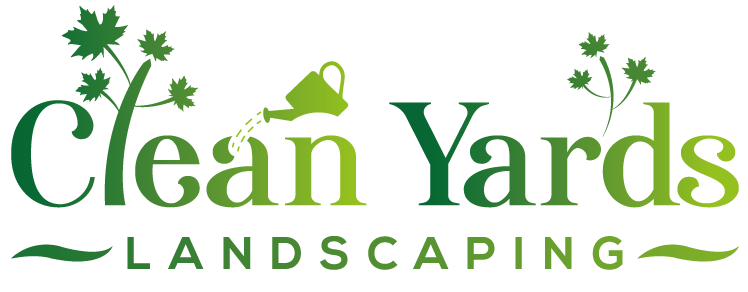Metcalfe Fall Pond Care: Prevent Costly Winter Damage
Quick Winter Prep Wins:
- Clean Thoroughly: Remove leaves and sludge before freezing.
- Manage Plants: Trim hardy plants, remove tropicals.
- Protect Fish: Stop feeding below 10°C, ensure deep water, maintain an ice hole (aerator/de-icer).
- Store Equipment: Remove, clean, and store pumps, filters, UVs frost-free. Drain pipes.
Following these steps helps avoid expensive spring repairs and keeps your pond healthy through Ottawa's harsh winter.
Ready to ensure your pond survives the winter? Get professional help!
Request a Pond Winterization QuoteIntroduction: Don't Let Winter Wreck Your Metcalfe Water Feature!
Ah, autumn in Metcalfe! The colours are stunning, the air is crisp, and it's the perfect time to enjoy your backyard oasis before the snow flies. But wait! Before you hang up your gardening gloves for the season, there’s one crucial task left: prepping your water feature for the notoriously harsh Ottawa winter.
Let’s face it, whether you're in Metcalfe, nearby Manotick, or over in Greely, our winters don't exactly whisper sweet nothings. Ignoring your pond or fountain now is like inviting Jack Frost over for a demolition party. Think cracked liners, busted pumps, and maybe even some very unhappy fish come springtime. *Ouch.* Those repairs can add up faster than squirrels burying acorns!
A little bit of preventative fall landscaping care for your water feature isn't just a nice-to-do; it's essential protection for your investment. Taking a few steps now can save you a *lot* of headache (and money!) later. Let's make sure your beautiful water feature survives the deep freeze and is ready to sparkle again when the warmer weather returns.
Why Ottawa Winters Demand Diligent Pond Prep
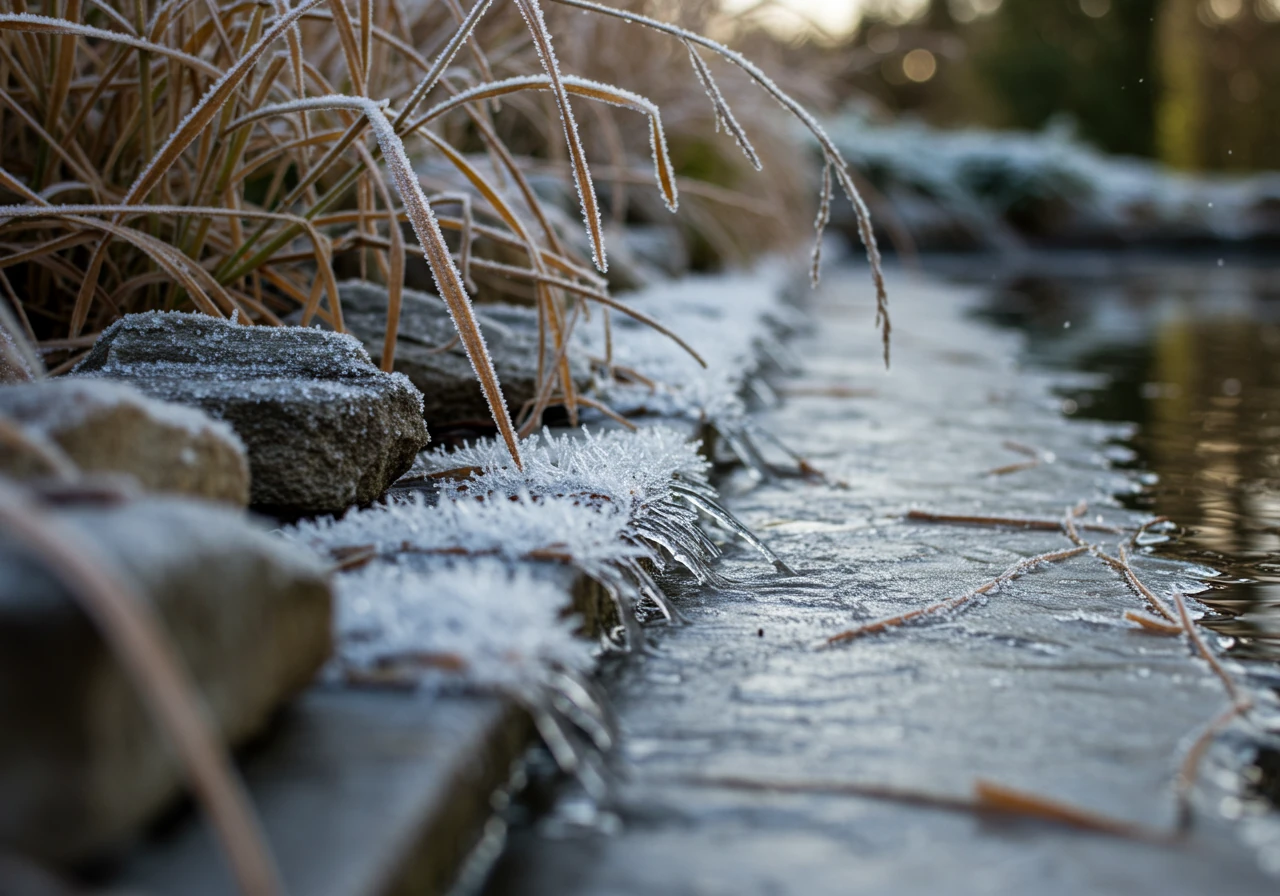
Alright, let's talk turkey – or maybe frozen fish, if we're not careful! Ottawa winters are legendary, and not always in a good way for our backyard ponds. Whether you're enjoying the peace in Osgoode or bustling around in Barrhaven, our region's deep freeze throws some serious challenges at water features. Ignoring pond prep here isn't just risky; it's practically asking for trouble when spring rolls around.
So, what exactly are we up against?
- The Big Freeze: It's not just a little ice skim here. Ottawa winters mean thick ice. As water freezes, it expands (remember science class?). This expansion puts incredible pressure on everything – your pond liner, the pump housing if you left it in (big no-no!), and any decorative stonework. Think of it like winter flexing its icy muscles right in your pond. This pressure can lead to cracks, tears, and leaks come springtime thaw. The ice cap also prevents oxygen exchange, which is bad news for any fish spending the winter in the pond.
- Snow Load Surprises: We get snow. Lots of it. While a fluffy white blanket looks pretty, heavy, wet snow can weigh down and damage protective netting or covers placed over the pond. Furthermore, spring melt-off, especially if it carries road salt or other contaminants from the surrounding landscaping, can suddenly change your pond's water chemistry if it all flows in. Ensuring your yard is generally tidy is part of the battle; check out these Comprehensive Fall Cleanup Services to Get Your Metcalfe Yard Ready for tips that benefit your whole property, pond included. A clean yard reduces debris entering the pond – consider services like Ottawa Yard Cleanup Service or Metcalfe Yard Cleanup Service for comprehensive care.
- Freeze-Thaw Cycles – The Real Menace: This might be the trickiest part. Ottawa weather loves to play games, bouncing above and below freezing, sometimes multiple times in a week. Each time water freezes and thaws in cracks, around the pond edge, or within your equipment seals, it expands and contracts. This constant stress weakens materials over time, much like bending a wire back and forth. It can shift edging stones, stress liners, and damage plumbing. It also affects the surrounding soil, causing ground heave that can push against your pond structure. Applying mulch around the pond edge can sometimes help moderate soil temperature swings – learn more about Metcalfe Mulch Magic: Expert Installation Tips or our Mulching and Edging services for ideas.
- Debris Dangers: All those gorgeous fall leaves? If left in the pond, they sink and decay over winter, releasing gases that get trapped under the ice. This fouls the water and can be harmful or fatal to fish. Proper gardening cleanup in and around the pond is vital. You can find great advice on dealing with plants in our guide to Metcalfe Fall Plant Care: Winter Prep for Your Gardens. Tackling this requires the right equipment, so ensuring your gear is ready is smart; take a look at Metcalfe Fall Garden Cleanup & Tool Maintenance Essentials.
Understanding these specific Ottawa winter challenges highlights why diligent pond prep isn't just fussy gardening – it's essential protection. Taking the right steps now saves you from headaches and costly repairs later. If the task list feels daunting, remember there are professional Landscaping and Yard Maintenance Services available to help ensure your water feature survives the winter unscathed. Check out our listing on Google for reviews and location.
Step 1: The Great Leaf & Gunk Eviction
Okay, team, let's roll up our sleeves (literally, maybe put on some waterproof gloves) for the first and arguably muckiest step: evicting all that autumn debris from your pond. Think of it as sending those pesky leaves and slimy gunk packing before they cause trouble over the winter!
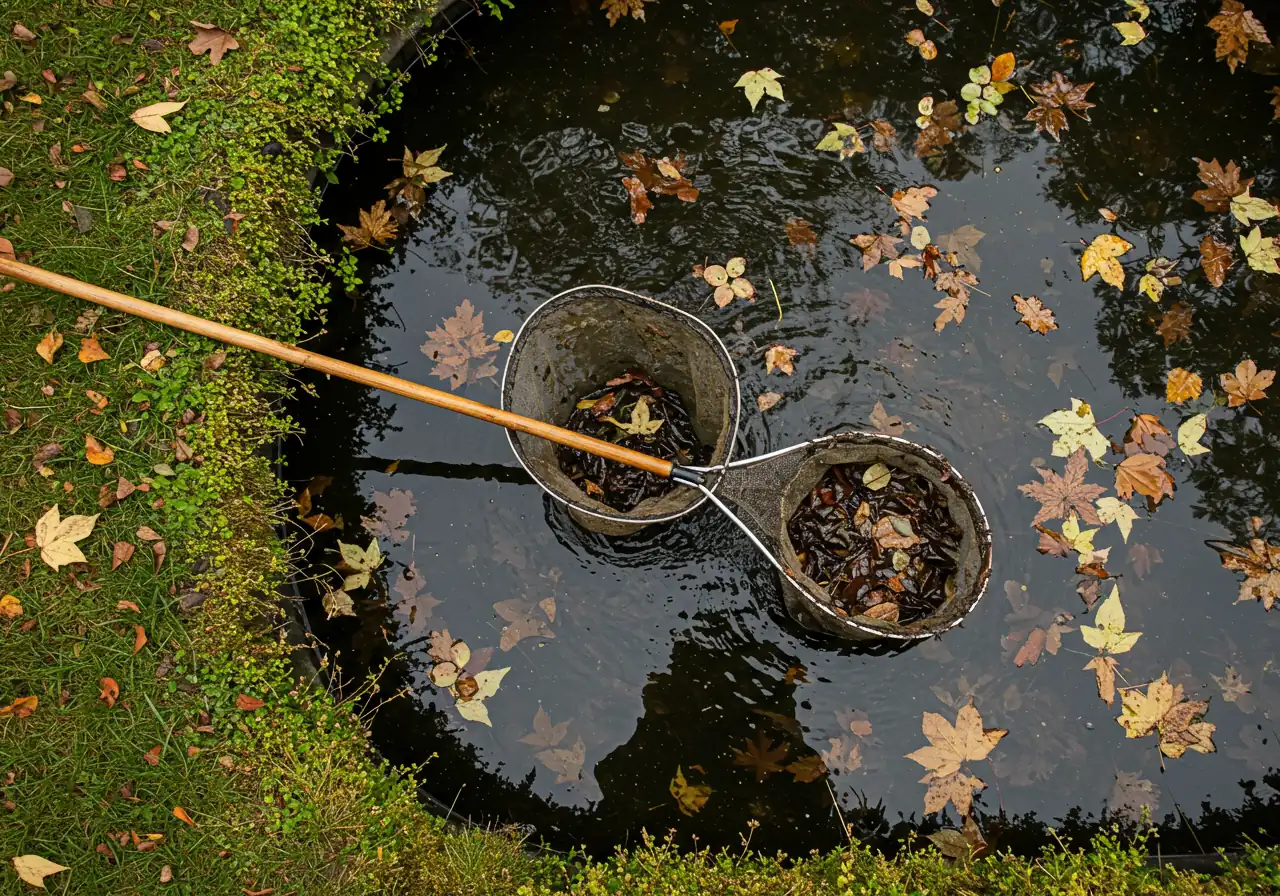
Why the Big Fuss About a Few Leaves?
It might seem like just a bit of gardening housekeeping, but getting leaves, twigs, and excess organic matter out of your pond *before* it freezes is super important, especially here in Ottawa. Once the ice caps over, anything left decaying at the bottom starts releasing nasty gases, like hydrogen sulfide (think rotten eggs – yuck!). These gases get trapped under the ice, fouling the water and, crucially, reducing the oxygen levels. If you have fish overwintering, this can be dangerous or even deadly for them. Clean water = happy hibernating fish!
Even if you don't have fish, letting that gunk decompose all winter makes for a much bigger cleanup job come spring. It can fuel algae blooms and make your water look like pea soup. A little effort now saves a *lot* of scrubbing later. This cleanup is a key part of overall fall landscaping maintenance, much like tidying up the rest of your yard. If the whole property needs attention, consider looking into a Professional Metcalfe Property Cleanup Service to tackle everything at once, or broader services like City Wide Property Cleanup Service or Marionville Property Cleanup Service depending on your location.
Gearing Up for Gunk Removal
You don't need super fancy equipment, but having the right tools makes the job much easier:
- A Long-Handled Pond Net: Your best friend for scooping floating leaves and reaching sunken ones. Look for one with fine mesh.
- A Pond Skimmer Net: Great for skimming fine debris off the surface.
- Waterproof Gloves: Keep your hands warm and dry (and less slimy!).
- Waders (Optional but Recommended): If you need to get *into* the pond for stubborn debris or plant trimming, waders are essential.
- Buckets or a Wheelbarrow: For collecting the scooped-out debris.
Let's Get Scooping!
- Skim the Surface: Start by removing all the floating leaves, twigs, and seeds. Do this regularly throughout the fall, especially if you live in a leafy area like Richmond or Kars where trees generously share their foliage!
- Net the Depths: Gently scoop out leaves and sludge that have already sunk to the bottom. Try not to stir things up *too* much, especially if you have fish.
- Trim Dying Plants: Cut back any yellowing or dead leaves from your aquatic plants, removing the cuttings from the pond. This prevents them from decaying in the water. Don't remove hardy plants entirely, just tidy them up. Considering where new plants might go next year? Get inspired by looking at Beautiful Garden Installation Ideas and our Material Selection process.
- Persistence Pays Off: Especially after windy days, you might need to repeat the skimming process. Some people install netting over their ponds during peak leaf-fall season to make this step easier.
Eco-Friendly Disposal
What to do with all that lovely pond muck? Don't just chuck it in the trash! Pond debris makes fantastic compost.
- Compost It: Add the leaves and sludge to your compost bin. It's rich in nutrients and will break down nicely. This is a great way to feed your garden beds later – think of it as free Expert Soil Preparation Assistance for next spring!
- Check Local Rules: Ensure you follow Ottawa's guidelines for green bin disposal if you aren't composting it all yourself. Check the City of Ottawa Green Bin Program for details.
Dealing with pond gunk might not be the most glamorous part of water feature ownership, but it's vital for a healthy pond that survives our tough winters. If the task feels overwhelming, remember that help is available. Many companies offer various Landscaping and Yard Cleanup Services that can include pond cleaning. It's often more efficient than trying to manage it alone, similar to how a dedicated City Yard Cleanup Service handles larger scale jobs.
Step 2: Tuck Your Plants in for a Winter Nap
Okay, now that we’ve evicted the leafy riff-raff and gunk (good riddance!), it's time to give your aquatic plants some TLC before winter arrives. Think of it as tucking them in for a long nap, ensuring they don't cause problems while dormant and are ready to thrive next spring. Skipping this step is like forgetting to turn down the thermostat before leaving on vacation – things can get messy!

Why Bother the Plants?
Just like the leaves we removed in Step 1, dying plant matter left in the pond over winter will decay. This decomposition consumes oxygen and releases harmful gases, creating a less-than-ideal environment, especially if you have fish. Proper gardening care for your pond plants now means better water quality through the winter and less sludge to clean up later. Keeping the whole property tidy helps prevent unwanted debris blowing into the pond; it's all part of good fall prep, something often covered by an Ottawa Area Property Cleanup Service.
Hardy vs. Tropical: Know Your Greenery
The key here is knowing what kind of plants you have, because their winter needs are totally different.
- Hardy Plants: These are the tough guys built for Ottawa winters. Think hardy water lilies, cattails, iris, and pickerelweed – plants commonly seen thriving in ponds from Nepean to the rural outskirts. They can generally stay right where they are in the pond, provided they're deep enough that their roots won't freeze solid.
- What to Do: Prune them back! Trim any yellowing or brown foliage down to a few inches above the water level or the crown of the plant. Don't cut them right down to the soil/gravel level. Remove all the trimmed bits from the pond (don't let them sink!). This prevents decay and keeps things looking neat. If dealing with soggy plant matter isn't your cup of tea, consider a Specialized City Garden Clean Up Service or Metcalfe Garden Clean Up Service to handle the trimming and removal for you. For plants in pots, you might want to move them to the deepest part of the pond to ensure they stay below the ice line.
- Tropical Plants: These are the warm-weather lovers, like water hyacinth, water lettuce, and tropical water lilies. Sadly, our Ottawa frost is their kryptonite – they simply won't survive being frozen. Some, like Water Hyacinth, are invasive in parts of Ontario - learn more from the Invasive Species Centre.
- What to Do: You have two main options:
- Treat as Annuals: This is the easiest route. Simply remove the tropical plants from the pond before the first hard frost and add them to your compost pile. Done and dusted!
- Overwinter Indoors (Attempt!): If you're feeling adventurous and have a favourite tropical plant, you can *try* to save it. This usually involves potting it up, keeping it in a sunny window or under grow lights, and maintaining moist conditions (sometimes even in a small tub of water). Success rates vary, and it requires dedication! Research specific instructions for the plant you want to save.
- What to Do: You have two main options:
Taking care of your plants now is a crucial part of winter pond landscaping. It protects your water quality and sets the stage for a beautiful return in the spring. While focused on your pond, remember that tidying the surrounding area is also key. If the whole yard needs attention, a Professional City Wide Property Cleanup Service can often handle it all. When hiring any service, it's always wise to review their scope of work and understand the Service Terms and Conditions before they begin. Think about next spring too! If the area around your pond looks a bit worn after winter, planning for improvements like Expert Sod Installation can revitalize the whole space.
Pond Winterization Timeline: Key Stages
Early Fall (Late Sept / Early Oct)
Begin regular surface skimming. Assess plants - identify hardy vs. tropical. Start reducing fish feeding frequency as water cools below 15°C.
Mid-Fall (Mid-Late Oct)
Perform thorough bottom cleaning (leaves/sludge). Trim hardy plants. Remove tropical plants. Stop feeding fish entirely once water stays below 10°C.
Late Fall (Late Oct / Early Nov)
Disconnect, clean, and store pump, filter, UV. Drain pipes. Install aerator or de-icer. Ensure water depth is sufficient for fish.
Winter (Dec - Mar)
Monitor the ice hole maintained by aerator/de-icer. Ensure equipment is running. Resist disturbing the pond. Plan spring startup!
Step 3: Ensuring Fishy Friends Survive the Freeze
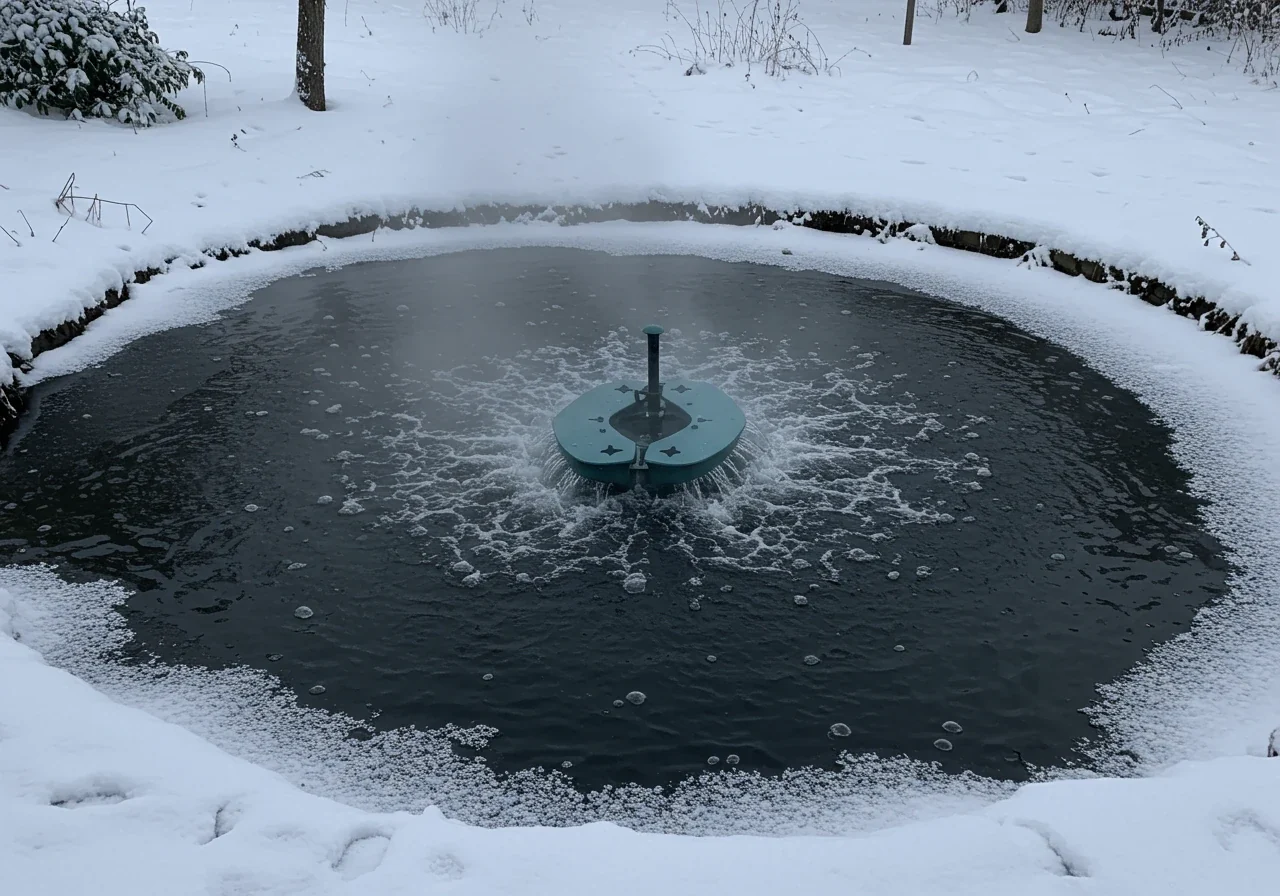
Alright, let's talk about the V.I.P.s (Very Important Pond-dwellers) – your fish! Keeping koi, goldfish, or other hardy pond fish safe through a frosty Ottawa winter isn't magic, it just takes a little understanding and prep. We want them cozy in their winter slumber, not frozen fish-sicles! Whether you're out near Winchester or closer to Kenmore, the principles are the same for helping them survive the deep freeze.
Dining Downshifts: Adjusting the Menu
As the water temperature cools, so does your fishes' metabolism. They start slowing down, kind of like us wanting a cozy blanket instead of running a marathon.
- Below 15°C (60°F): Switch to a low-temperature, easily digestible wheat-germ-based fish food. Feed less often than you did in summer.
- Below 10°C (50°F): Stop feeding altogether! Their digestive systems basically shut down for the winter, and undigested food can rot in their gut, causing serious health problems. They have stored enough body fat to see them through till spring. Resist the urge to toss food in on a sunny winter day – it genuinely does more harm than good.
The Deep Sleep: Why Depth Matters
Ever wonder how fish survive under ice? They hang out near the bottom! Water is densest and warmest at 4°C (39°F), so the deepest part of your pond usually stays around this temperature, even when the surface is frozen solid. This deep zone is their winter refuge. Consult local resources like the Rideau Valley Conservation Authority for information on local aquatic life.
- Minimum Depth: For Ottawa winters, your pond must have an area at least 2 feet (60 cm) deep, though 3-4 feet (90-120 cm) is much better and provides a safer, more stable environment. This gives fish ample room below the typical frost line. If your pond is too shallow, you might need to consider bringing the fish indoors for the winter (which is a big undertaking!). Proper pond design during the initial landscaping phase is crucial for long-term fish survival.
Breathing Room: Keeping a Hole in the Ice
A solid sheet of ice covering the entire pond surface is bad news. It prevents essential gas exchange – oxygen can't get into the water, and harmful gases released from any remaining decaying matter (remember Step 1’s gunk eviction?) get trapped beneath the ice. You must maintain at least a small opening in the ice throughout the winter.
- Aerator vs. De-Icer: Your Winter Lifelines
- Pond Aerator: This device pumps air through a diffuser stone placed near the pond bottom (but not *right* at the very deepest point, as you don't want to disturb the warmest water layer where fish rest). The rising bubbles create water movement, which keeps a small area ice-free. Crucially, it also directly adds vital oxygen to the water. Aerators are generally quite energy-efficient.
- Pond De-Icer (also called a pond heater): This unit typically floats on the surface and uses a heating element to melt a hole in the ice, directly allowing for gas exchange. It doesn't add oxygen itself but ensures the pathway is open. De-icers often use more electricity than aerators but are thermostatically controlled, switching on only when temperatures drop near freezing.
- Which should you use? Many Ottawa pond owners successfully use just an aerator, especially in deeper ponds. Some prefer the belt-and-suspenders approach of using a de-icer as a backup or primary method. An aerator running consistently often provides the most benefit due to the added oxygenation.
CRITICAL WARNING: Never, ever try to break or smash a hole in the ice! The force and shockwaves travel through the water and can severely stress, injure, or even kill your dormant fish. Please, let your aerator or de-icer do the job gently and safely.
Keeping your fish safe is a vital part of winter pond gardening and maintenance. This focused care complements the broader tasks needed for your entire property during the fall shutdown. Remember that neglecting the surrounding yard can lead to more leaves and debris blowing into the pond later, potentially adding to the gas buildup under the ice; consider Overall Property Clean Up to minimize this risk. Whether you are managing a small backyard pond in the suburbs or require assistance similar to what a Marionville Property Cleanup Service might provide for a larger rural estate, the fish care principles remain the same. Some homeowners find it most efficient to integrate pond winterization into a larger fall package, like a City Wide Yard Cleanup Service. If you've already tackled the leaves and plants yourself but need a hand with equipment setup or heavier aspects of winter prep, you might look into an Ottawa Area Property Cleanup Service.
Taking these steps carefully will greatly increase the chances of greeting your happy, healthy fishy friends come springtime. They’ll surely thank you for the cozy winter setup! If you have further questions about preparing your pond or need professional help getting everything winter-ready, you can find our contact details and more information via our Thank You Page.
Fish Care Deep Dive
Key Points: Stop feeding below 10°C. Ensure 2ft+ depth. Provide open water via aerator/de-icer. Hardy fish like Koi and Goldfish usually manage well if conditions are right. Monitor their behavior in late fall; slow movement is normal.
Equipment Tips
Key Points: Remove pumps/filters/UVs *before* freezing. Clean thoroughly. Store pump submerged in water, frost-free. Drain all pipes completely; use air compressor if possible. Store UV bulbs/sleeves carefully indoors.
Common Winter Issues
Key Points: Ice damage (cracked liners/equipment). Fish loss (lack of oxygen, shallow depth). Spring algae blooms (excess winter decay). Freeze-thaw damage to edges/pipes. Proper prep prevents most issues!
Step 4: Winterizing Pumps, Pipes, and Filters
Okay, let's dive into Step 4 – protecting the heart and circulatory system of your water feature! Winterizing your pumps, pipes, and filters might sound technical, but it's mostly about getting the water *out* before Jack Frost does his worst. Trust us, replacing frozen-and-cracked equipment is a springtime headache (and wallet-ache!) you really want to avoid.
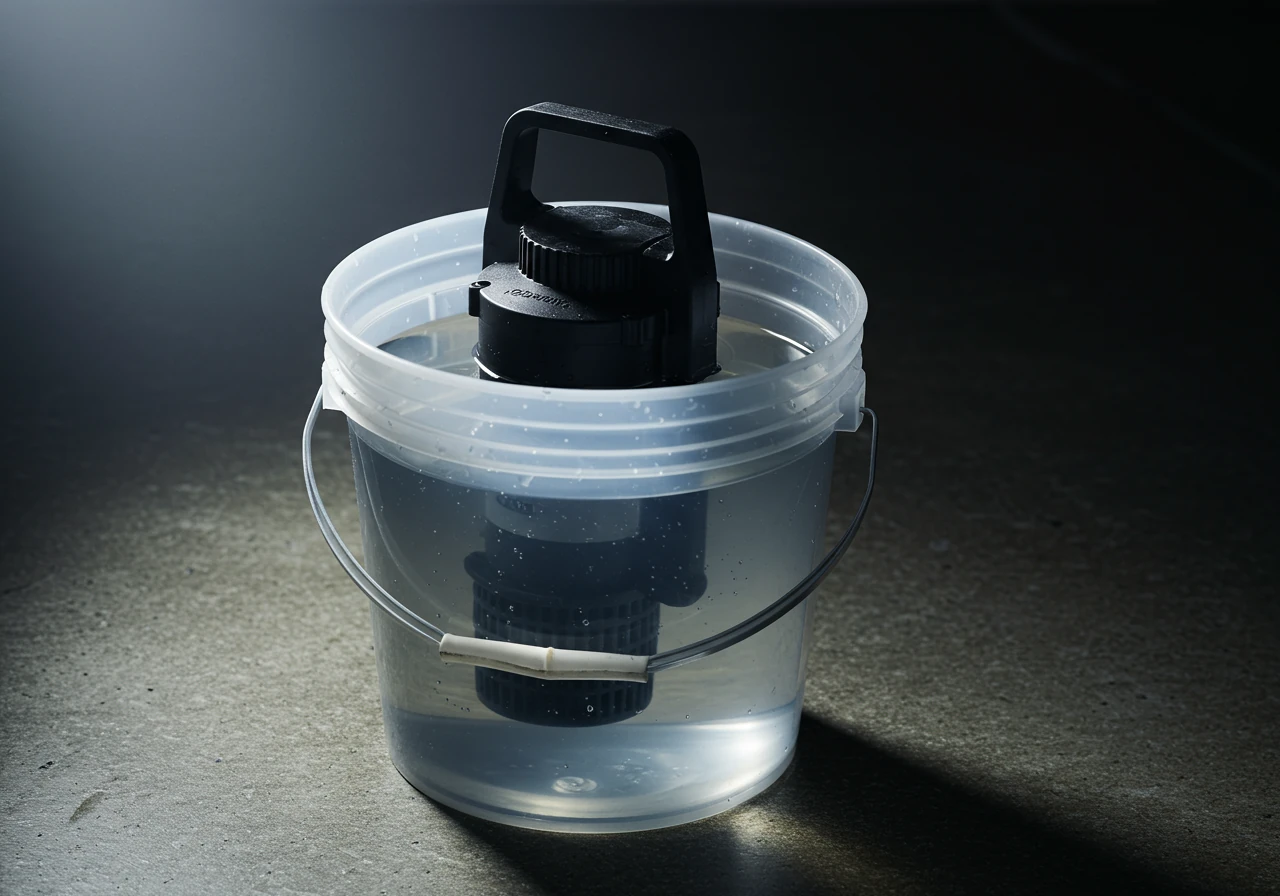
Think of it this way: water expands when it freezes. If that water is trapped inside your expensive pump or filter housing, *crack*! goes the plastic or metal. It's the same reason pipes burst in unheated cottages. Our Ottawa winters, whether you're in Russell or over in Embrun, don't mess around with freezing temperatures, so this step is non-negotiable for most equipment.
Here’s how to tuck your gear in safely:
- The Pump Pull-Out: This is your water feature's engine. Leaving it in the pond is asking for trouble.
- Why: Water inside the pump housing will freeze, expand, and likely crack the casing or damage the impeller. Bye-bye, pump!
- How: First, *always* disconnect the power supply at the source (breaker). Safety first! Then, carefully lift the pump out of the pond. Give it a good clean, removing any leaves or gunk. Check your manufacturer's instructions – most recommend storing the pump submerged in a bucket of water in a frost-free place (like a basement or heated garage). This keeps the seals moist and prevents them from drying out and cracking. Storing it dry is sometimes okay, but check the manual!
- Filter Freedom: Your filter worked hard all season keeping things clean; now it needs a winter break.
- Why: Just like the pump, water trapped in the filter housing, UV components, or even saturated filter media can freeze, expand, and cause damage. Biological media relies on living bacteria that won't survive freezing anyway.
- How: Disconnect the filter from the plumbing. Drain it completely – there's usually a drain plug. Open it up and remove the filter media (pads, bio-balls, etc.). Clean the media according to the manufacturer's instructions (some pads need replacing, others just a good rinse – avoid soap!). Clean the inside of the filter housing. Store the housing and the cleaned, dry media in a frost-free location. Tackling this cleaning might feel like part of a larger gardening project; similar dedicated attention is offered by services like the Metcalfe Garden Clean Up Service for terrestrial gardens.
- UV Clarifier Care: These have fragile quartz sleeves that need extra TLC.
- Why: The quartz sleeve housing the UV bulb is *very* brittle. Any water freezing inside will shatter it instantly. The bulb itself is also sensitive.
- How: Disconnect and drain the unit completely. Carefully remove the UV bulb and the quartz sleeve. Clean the sleeve gently (vinegar often helps with mineral buildup) and dry it thoroughly. Store the bulb and sleeve indoors in a very safe place where they won't get knocked over or broken. Store the empty housing dry. Protecting these components prevents costly replacements and ensures your feature looks its best, maybe even as good as some of the amazing Backyard Water Feature Transformations we've seen!
- Pipe Preparedness: Don't forget the water pathways!
- Why: Water left in pipes or tubing will freeze, expand, and can easily crack rigid PVC pipes or split flexible tubing.
- How: Disconnect pipes from the pump and filter. Drain as much water as possible by tilting them or using gravity. For thoroughness, use a shop vac on reverse or an air compressor (use *low* pressure!) to blow any remaining water out of the lines. If pipes run underground and can't be fully drained, they *must* be rated for burial below the frost line, but blowing them out is still the safest bet. Stuff the open ends of pipes with foam plugs or rags (just remember to remove them in spring!) to keep critters and debris out. This level of detailed care is common whether handling a small backyard feature or coordinating a larger project akin to a Marionville Garden Clean Up Service on a bigger property, or even our Marionville Yard Cleanup Service.
Taking these steps diligently protects your investment in landscaping equipment. If you're ever unsure or need assistance, reaching out for professional help is always an option. You can contact us for advice or service inquiries – feel free to use the form on our Contact Us Page after reviewing our site. We respect your data; you can view our commitment to this in our Privacy Policy. Properly winterized equipment means a smoother start-up next spring!
Pond Prep Effort vs. Impact
*Relative effort/impact visualization for typical ponds.*
Metcalfe Pond Winter Prep: Quick Checklist
Feeling a bit overwhelmed by the pre-winter pond tasks? Hey, we get it – preparing for an Ottawa winter can feel like a marathon sometimes! Read more About Us and you'll see we understand the challenges homeowners face here in Metcalfe and beyond. To make it easier, here’s your super-quick checklist of the essentials:
- Scoop the Gunk: Get those autumn leaves, twigs, and bottom sludge out *before* the freeze! A clean pond is crucial for overwintering success, reflecting the kind of thoroughness you'd expect from detailed work like a Marionville Garden Clean Up Service.
- Plant Prep: Trim back your hardy aquatic plants (like lilies and iris) above the water line. Completely remove tropical plants – they won't survive the frost. Smart pond gardening now prevents issues later.
- Fish Safety First: Stop feeding fish when water temps stay below 10°C (50°F). Ensure they have deep water (2ft+). *Crucially*, maintain a small hole in the ice using an aerator or de-icer for gas exchange – *never* smash the ice!
- Equipment Evacuation: Remove pumps, filters, and UV sterilizers. Clean and store them somewhere frost-free (often in a bucket of water for pumps). Drain all pipes and tubing completely to prevent cracking.
Ticking these key items off your list is the best way to protect your water feature investment and ensure a healthy start next spring. Remember, taking care of the surrounding landscaping also helps by minimizing debris blowing into the pond. If this list still feels daunting, remember comprehensive help is available through options like our Ottawa Yard Cleanup Service. Got questions or need a hand with the heavy lifting? Just Contact Us – we're happy to help!
FAQs: Your Ottawa & Metcalfe Pond Winter Worries Answered
Great question! You’ll want to tackle most pond winterizing tasks *before* the first hard, lasting frost hits Ottawa, typically aiming for late October or early November. The key trigger is when water temperatures consistently stay below 10°C (50°F) – that's your cue to stop feeding fish and get equipment out. Don't wait until the snow flies! If you're feeling behind, focus on the critical steps like fish feeding and getting the pump out ASAP.
Uh oh, 18 inches is quite shallow for our tough winters. Fish need at least 2 feet (and ideally 3-4 feet) of depth to safely retreat below the ice where water stays around 4°C. In a shallow pond, there's a real risk of it freezing solid or becoming dangerously cold. You might need to bring the fish indoors (a separate tank setup) or invest in a reliable de-icer *and* aerator running constantly. Perhaps consider deepening the pond next landscaping season? We're happy to discuss options; you can always provide details when requesting information via our Estimate Feedback Form.
Good point – why double up if you don't have to? For most Ottawa ponds, especially deeper ones, a properly sized aerator running 24/7 is often sufficient. It keeps a hole open for gas exchange *and* adds vital oxygen. A de-icer primarily just melts a hole. Some folks use both for extra peace of mind, particularly in shallow ponds or during extreme cold snaps. An aerator is generally more energy-efficient and beneficial overall.
Resist the urge to add pond shoveling to your winter chores! A layer of snow usually won't harm anything and can even provide a bit of insulation. The critical thing is keeping a hole open for gas exchange, which your aerator or de-icer handles. Just ensure heavy snow isn't collapsing any protective netting you might have. Focus instead on keeping the surrounding yard clear to prevent messy spring runoff; good overall Relevant Lawn Care Services contribute to a healthier pond environment year-round. For agricultural properties needing similar care, resources from OMAFRA might be helpful.
Ah yes, the masked bandits! Thankfully, winter slows down most wildlife activity. Ensure your pump and filter are securely stored away (Step 4!). While raccoons *might* be drawn to the open water spot created by your de-icer for a drink, your fish should be safely dormant in the deeper, colder water, generally ignoring surface disturbances. Keeping the area around the pond tidy with good garden maintenance reduces hiding spots and attractions. Regular Professional Garden Maintenance can help manage the overall landscape appeal to critters.
You're right, those mid-winter thaws followed by deep freezes can be sneaky! The biggest risks are to anything holding water near the surface: pumps/filters left in (big no-no!), the pond liner edge if water seeps behind it and refreezes, and surrounding stones or landscaping features getting shifted by frost heave. Properly removing equipment and ensuring the pond edge is stable are key. Using mulch can help insulate the ground; check out Mulching and Edging Solutions for ideas on stabilizing pond surroundings.
Conclusion: Enjoy Winter Peace of Mind for Your Metcalfe Pond
Whew! We've covered a lot, from battling leaf gunk to tucking in fish and equipment. Taking these fall pond preparation steps might seem like just another chore on your landscaping list, but think of it as buying yourself some serious winter peace of mind. No more worrying about cracked pumps or unhappy fish when the Ottawa snow starts piling up!
Proper winterization protects your investment, prevents costly spring repairs, and ensures your beautiful water feature bounces back quickly when the warmer weather returns. Imagine, next spring, instead of dealing with murky water and broken parts, you're simply enjoying the delightful sounds and sights of your pond waking up – easy peasy! It's smart gardening that pays off.
So, go ahead, tackle that checklist! Whether you’re in Metcalfe, Osgoode, Greely, or Manotick, giving your pond a little autumn TLC means you can sip your hot cocoa worry-free this winter.
Feeling like you’d rather leave the chilly tasks to the pros?
We don't blame you! If getting your hands cold and mucky isn't your idea of fall fun, we’re here to help. Contact Clean Yards today for professional pond winterization services. Let us handle the prep work so you can relax and look forward to a vibrant, healthy pond next season. Enjoy the quiet beauty of winter, knowing your pond is safe and sound!
